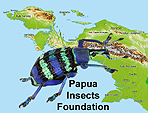.jpg)

The Papua Insects Foundation
How to catch and prepare mantids (Mantodea)
by Kai Schütte
Basic information
The mantids are an insect order that occurs with about 2400 species nearly all over the world (mostly in the tropics and subtropics). They sometimes look similar to roaches or stick insects, but they have the characteristic raptorial forelegs. The carnivorous insects catch their prey with these forelegs. The mantids are hemimetabol insects which indicate that the nymphs look very similar to the adults. Mostly, the adults are winged, including 3 possible types of wings:
- wings longer than the body (abdomen)
- wings a little shorter than the abdomen
- very short wings with most of the abdomen visible.
There are also a few apterous (without wings) species. Bigger nymphs of the winged species have some “little growing wings” that become bigger from moult to moult. Often you will find a dimorphism between females and males. The females are a little bigger and more massive as they produce the eggs. The males are sometimes smaller and often have slightly longer wings.
A Mantis with a lycaenid as prey near Merauke
Where to find mantidsMantids live everywhere (except in or on the water). You will find them on the ground, in the grass, on bushes, on tree trunks and in trees. It is important to look carefully because often they hide very well and look very similar to the vegetation or to the bark of the trees. The winged males are able to fly and at night they are often attracted to light.
The females who are going to produce an eggcase are often too heavy to fly but can be attracted by light, too.
The ootheca
The eggcase, called ootheca, can contain (depending on the species) 10 to several hundred eggs. The females produce a secret with the end of their abdomen and deposit the eggs inside. The foamy secret hardens after some time in the air. The oothecas are laid mostly on the vegetation, on bark or on stones. The eggs hatch after some weeks (about 3-8, sometimes diapauses can slow down development over half a year).
Mantis laying ootheca at Warkapi (Arfak Mts., Birdshead Peninsula)
How to prepare the mantids for a collection
To identify the species it is important to have adult mantids, because often it is impossible to identify the nymphs with their larval characteristics. You should use an insect net or a little plastic container to catch the mantid. Then the caught animal can be manipulated into a preparation tube (with alcohol or ether), which will sedate it immediately. After 10 minutes the insect is dead and can be prepared. The mantid should be dried very well for the transport. Often you have to open the abdomen at one side (metapleural zona) of the gravid females and take out the entrails to avoid rotting. This procedure needs some training and adroitness but it´s important not to cut off the whole abdomen because it´s necessary for the determination. Thin females and males can often be dried without this procedure. The best preparation for the transport is to put the well dried mantid on a piece of cardboard and wrap some plastic (film) around it, so that none of the legs, the wings, or the head can break off. Other insects like beetles and small Psocoptera could eat and harm the dead insects and it is necessary to control them regularly. If vermin occurs try to freeze the material or use insecticides to avoid destruction.
For every specimen the basic data should be recorded on a small sheet (or on the cardboard): datum of catch, locality of catch, name of the collector.
How to rear mantids and obtain oothecas from the females
If you find an adult female mantid in nature you can presuppose that it is mated. You should separate (because it could also eat other mantids) the female in an airy container (e.g. plastic box with one side of fine plastic mesh) and feed it well with other insects (e.g. flies, crickets, grasshoppers, butterflies...). After some time it will lay one of several oothecas. To give away the ootheca, you should send it soon (in the next 1-2 weeks) before the nymphs will start to hatch.
Mantis nymphs on Japen Island